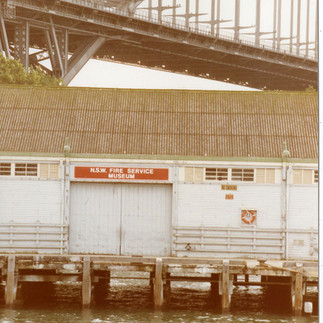Establishing the Museum of Fire: A Look Back at Our History
- Museum of Fire Heritage Team
- Jul 23, 2024
- 3 min read
We focus so much on telling other people’s stories in this blog that we thought we would take the time to tell you our story, and how the Museum of Fire came to be.
The Museum’s history begins with the establishment of the Historic Fire Engine Association of Australia (HFEAA; now known as the Historic Fire Engine Association). In 1968 Brian Blunt and Bob Winch purchased a Dennis Big 4 fire engine from the Board of Fire Commissioners of NSW (now Fire and Rescue NSW, FRNSW), where it was registered through the Historic Commercial Vehicle Association (HCVA) which Brian was a member of. It was through this organisation that Brian found more people who were interested in historic fire engines, so it was decided to create their own organisation dedicated to the collection and preservation of fire engines, with their first meeting being held in March of 1969.
Over the years, the HFEAA member numbers continued to grow, and so too did the number of historic fire engines they acquired. In 1971, the HFEAA acquired their first fire engine specifically for preservation reasons, this being the Leyland FT3 pumper which was the only example of this appliance in Australia.
In 1975 the HFEAA was invited to run a museum at the brand-new NSW Fire Brigades (now FRNSW) Alexandria Training College, however, it wouldn’t be until 1979 that the museum was opened and became known as the Fire Services Museum. Along with several fire engines, other heritage items on display included the 1909 switchboard by Edward Smith which came from Headquarters Fire Station (now City of Sydney) on Castlereagh Street in Sydney. You can still see this switchboard on display today!

The 1980s brought lots of change
In 1980 the Ahrens Fox, Shand Mason, Garford and other equipment were returned from loan to the NSW Fire Brigades from the Museum of Applied Arts and Sciences (also known as the Powerhouse Museum). These highly significant vehicles and objects were then subsequently transferred to the Fire Services Museum. Also in 1980, it was suggested that the Museum find a new home as the space was unsuitable for a museum and the Board of Fire Commissioners of NSW wanted to expand the training facilities into the Museum space. A new premises was acquired at Pier 4 & 5 Walsh Bay, and on 10 January 1981 the Museum was opened to the public under a new name, the NSW Fire Services Museum. It was open to the public on a regular part-time basis, manned by dedicated volunteers from the HFEAA.
Just three years later in 1984 the Museum had to move again into a temporary location on Pier 7 at Campbells Cove (now the Park Hyatt Sydney) due to renovations being conducted at Walsh Bay by the Sydney Theatre Company. They re-opened to the public on 1 July 1984, then only a year later the Museum had to move again due to the area being redevelopment for the Australian Bicentenary. During 1984 the Museum also saw its first full-time director appointed, this being Julian Faiger, who would continue in the role until 1989.
Moving to Penrith
After many sites were investigated for their suitability, the Museum made its fourth (and final) move to Penrith in 1985. While the move was relatively straightforward, it would take twelve months to clean and convert the old power station into a modern museum space for the community.

At the time of possession, the building had stood vacant for fifteen years. Owing to its many years of disuse, the building was plagued with broken windows and a build-up of debris. A largescale building restoration program was implemented, with volunteers giving countless hours of their time to clean and restore the building over the next twelve months. Volunteer labourers and local businesses supported the restoration program, with the Rotary Club of Penrith in conjunction with the Board of Fire Commissioners of NSW sponsoring a Community Employment Program which assisted in upskilling dozens of local individuals who were facing unemployment.

On 16 November 1986, the Museum of Fire was officially opened to the public under this new name. Over the years, the Museum has undergone further renovations to be able to host a variety of exhibitions and public programming, bringing new and engaging content to the public over the last nearly 40 years.

To read more about how the Museum moved to Penrith click here.
-Story by the Museum of Fire Heritage Team







Comments